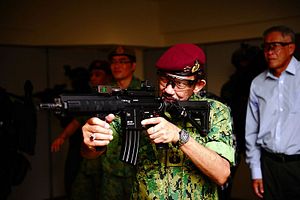Last week, Brunei’s second defense minister once again reiterated the fact that the Southeast Asian state would look to release the next iteration of its defense white paper in 2021. Though this is only one among developments in the country’s security domain, it nonetheless remains important to watch to assess the extent of continuity and change in elements of the country’s defense approach as well as its broader domestic and foreign policy.
As I have noted before in these pages, though Brunei’s security role is often overlooked, the tiny, oil-rich sultanate has nonetheless exercised its own influence in various ways in the management of opportunities and challenges with respect to some regional developments, be it its role as a quieter claimant in the South China Sea disputes or the advancement of certain developments in the ASEAN multilateral framework such as counterterrorism or confidence-building.
While Brunei tends to have a relatively lower profile in terms of its defense priorities, the country’s release of defense white papers has provided occasional public glimpses into its thinking. Indeed, even Brunei’s first publicly released defense white paper, released in 2004 offered at least some insights into how the country viewed its security challenges and what instruments it would use to manage them.
But the security environment in general and Brunei’s role within it more specifically have both changed quite significantly since the release of the last defense white paper back in 2011. Within the Southeast Asian security environment, while there has been the continued presence of a range of threats including terrorism, piracy, and territorial and maritime disputes, there are important shifts as well, including the increasing constraints faced by ASEAN as an institution and rising U.S.-China tensions. And with respect to Brunei itself, though the broad contours of its defense policy may be quite similar, there have been consequential shifts as well which have come from several trends including defense budget cuts in previous years.
Within that broader context, one of the developments that observers have been looking to is a sense of when Brunei will be releasing the next iteration of its defense white paper. While the development is only one among several indicators of where the country is and where it is headed in the security domain, it nonetheless offers an important, longer-term measure of this relative to headline-grabbing developments such as annual defense budget figures.
Officials had previously indicated that the next defense white paper would likely be released sometime in 2021, which would be in line with the 60th Royal Brunei Armed Forces Anniversary. And during a keynote address delivered to the participants of the 9th Command and Staff Course at the Command and Staff College of the Royal Brunei Armed Forces Defense Academy on May 13, Brunei’s second defense minister once again reiterated that this would be the case.
Per Brunei’s defense ministry, during the keynote address, which touched on several aspects including the contemporary security environment in Southeast Asia, the role of various elements of the security order including ASEAN, and where Brunei fits into these general trends and developments at play, he highlighted Brunei’s upcoming defense white paper as being one significant manifestation of this.
If and when the release of Brunei’s defense white paper is realized, it would no doubt constitute a significant development for Brunei’s defense policy as with previous iterations in this vein. It would also offer defense watchers valuable insights into the country’s thinking in this domain, especially given uncertainties over the country’s position on matters ranging from defense procurement to alignments with major powers to the South China Sea disputes.
To be sure, specifics, such as timing and content areas, remain unclear given that this is still a work in progress. And whatever the white paper’s contents, it will also build on existing foundations, including previous policy contours such as the three strategic defense pillars of deterrence and response, defense diplomacy, and holistic defense or the seven priority areas reflected in the rather unwieldy acronym IKWONDAMAI. Furthermore as with other countries, it also bears emphasizing that there are limits of what a defense paper can do for Brunei, since the articulation of defense thinking is just one aspect of broader defense policy – which rests not just on what a government says, but how it actually acts with respect to a range of areas including budget allocations, alignments, and threat prioritization, as well as how it then manages defense policy relative to its broader domestic and foreign policy.
How exactly all of this plays out will become clearer if and when we get closer to the defense white paper’s actual release, along with other developments such as those tied to the sultanate’s Wawasan 2035 vision. But among the many ongoing issues within Brunei’s defense policy, this significant development will be among the ones to watch over the course of the next few years.






























